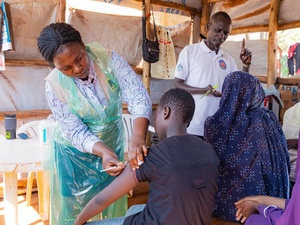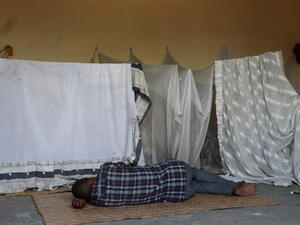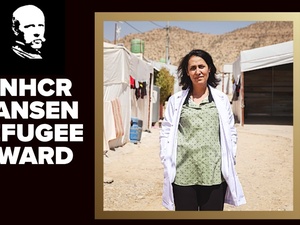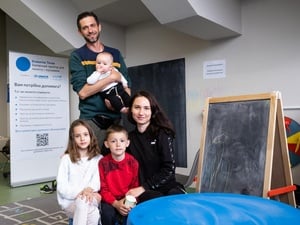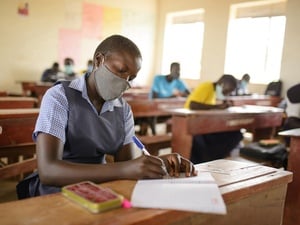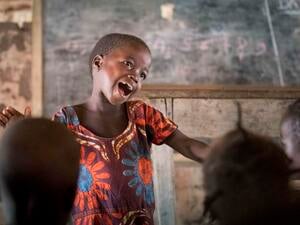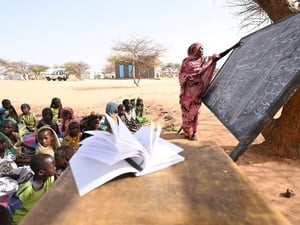Saving Somali children: Striving to stave off a health crisis in Ethiopian camp
Saving Somali children: Striving to stave off a health crisis in Ethiopian camp

UNHCR's Doctor Chris Haskew examines an emaciated Somali refugee in Kobe camp, eastern Ethiopia.
KOBE REFUGEE CAMP, Ethiopia, August 26 (UNHCR) - Every grave tells a story and today the gravedigger relates the tale of a little Somali girl. First, she had diarrhoea. Then a fever and rashes surfaced on her body. Her eyes turned red. Over five days her condition grew worse. Finally, 10-year-old Hawaba Maday Issak perished. She was the fourth child in her family to die in the last 45 days.
The graves at Kobe refugee camp are scattered here and there and their existence screams of an urgent condition. Between June 24, when the facility opened in eastern Ethiopia, and August 12, investigators found 16 grave sites containing 562 bodies. Of those, 476 were considered to be children under five years of age. Some are concentrated around the camp's centre while others sit along the outskirts. The graves are covered with little stones or thorn bushes to mark them for passers-by.
In a camp the size of Kobe, if two children (aged five or under) die each day it is considered an emergency. On average, it is estimated that 10 children have died every day in Kobe since it opened. Acute malnutrition makes both children and adults vulnerable to everything from measles to pneumonia and is a major cause of the child mortality.
UNHCR and its partners are urgently working to stave off an acute health crisis in Kobe camp. Doing so is one of the most difficult tasks imaginable. The camp is filled to capacity with about 25,000 civilians who have fled from drought, famine and conflict in neighbouring Somalia. During the day the heat is stifling. At night the winds are strong enough to overturn makeshift dwellings and cold enough to give a child pneumonia or worse. With malnutrition hovering in the wings, immune systems are reduced. Disease and death are never far off.
But medical staff labour from dawn until well into the evening to help the sick while UNHCR and others have flown in tents for the refugees and provided water and latrines. Just as importantly, the refugee agency is teaching the importance of health and hygiene to people who, due to 20 years of conflict in their homeland, have been denied an understanding of basic health and medicine.
Chris Haskew, a UNHCR health officer, approaches the crisis with the rigour of a detective. He examines the sizes of the graves - the only sure way to map the rate of mortality in the camp. He puts himself mentally in the place of individual refugees, attempting to discern the weak points of the camp's health and nutritional ecology.
How can a woman who is sick travel to a far away water point, especially if she has children to watch over? How much does it cost and how long does it take for a family to take their children to a hospital? Will they have enough money or means to feed the others if they have to return as outpatients? What happens if an adult cannot move but must nevertheless be taken to hospital? Why do a significant number of parents take their children out of hospital when they show the first signs of improvement?
"People aren't dying spontaneously; we can be systematic, we can be scientific in analyzing this problem," says Haskew. "This is a fundamental type of protection. We can do people the dignity of documenting what has happened."
Even as the threat of disease casts a shadow, the results of the efforts of UNHCR, the Ethiopian government and other partners can be seen everywhere. One month ago there were perhaps eight functioning water points in the camp. Now there are 24. A month ago, there were approximately 30 latrines. Now there are 240. The vast majority of camp dwellers now have a tent for shelter.
But despite these remarkable efforts, there isn't a single person working at the camp who is satisfied. "For me, the biggest achievement is that the international response has arrived," says Jo Hegenauer, head of UNHCR's Dollo Ado sub-office. "You have strong staff making strong improvements. But we still have a [long] way to go."
UNHCR Field Officer Hossein Sodagar has just managed to move two families from their makeshift home of twigs and rags on the outskirts of the camp to the interior of Kobe, where there is a more comfortable tent. He helps the elderly woman pack up her belongings and places them in the back of his car before driving her to the new location. He knows that if he can get two families to move, the rest of the community will follow. The elderly woman sits in her new tent beaming when one of her neighbours begs Sodagar for his help.
Then he finds Hindia Abdille, 35, with her three children lying ill in the shade. Her six-year-old daughter, Adoy, coughs incessantly and cannot swallow food. Adoy's brother Hussein, aged eight, is just skin and bones. Like his other sister, Sokoro, the shivering boy has rashes and his eyes are nearly shut.
Abdille's voice grows high pitched as she explains how she lost her youngest child, four-year-old Nimo. Abdille took the girl to the camp hospital and was given medicine several weeks ago. The child rallied before taking a turn for the worse. "We took her back to the hospital and when the doctor looked at Nimo, she rolled up her eyes and died in front of us." She now gives her surviving children traditional remedies, but they are getting worse and Abdille is beside herself.
Sodagar gathers the three little ones and their mother, puts them in his vehicle and drives them approximately two kilometres to the Médecins Sans Frontières hospital. In the outdoor waiting area a man tries to clean his child, who is so emaciated he can barely move. A doctor arrives holding the hand of a boy, who has just had an epileptic fit. Despite the number of patients, the doctor manages a smile. "Ah, more visitors," he says while holding the hand of another malnourished child. "Come in. Welcome."
"Every day that we go out into the camps we see sick people," says Sodagar. "We go out for something else and we always end up coming back as an ambulance." The veteran field officer has never been in a situation so challenging. "When I see people so desperate and left alone it is as if a member of my family had been left like that," Sodagar says. "I think, 'What would I have done for that person if they were my family.'"
And yet he knows that this crisis requires him do much. Tents have to be erected. Water and sanitation are necessary. Health efforts need to reach those on the very edges of the camp. Each effort needs to be coordinated in order to be successful.
While Sodgar works on one side of the camp, UNHCR Community Services Officer Katie Ogwang leads a women's group meeting on the other. The thought of measles and malnutrition is a 24-hour preoccupation of many of the women and, among many other things, Ogwang is there to empower them with information on health and hygiene. After the talks, she visits women in the camp.
Ogwang knows that changing habits requires more than just meetings and lectures. The fear of disease threatens to disrupt the social fabric. One woman is sick and cannot wash her child. Others in the community worry that if they come to the house they too may become sick. Ogwang washes the child. Another woman is sick and cannot make food for her children. Ogwang cooks porridge.
"Washing a child drops a seed into the life of a community," she says. "It shows people that if I can help a stranger, then they can help a neighbour. Every gesture can make a difference."
By Greg Beals in Kobe Refuge Camp, Ethiopia


